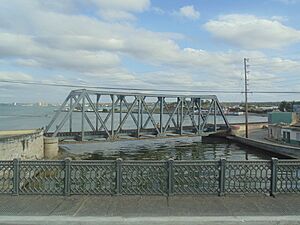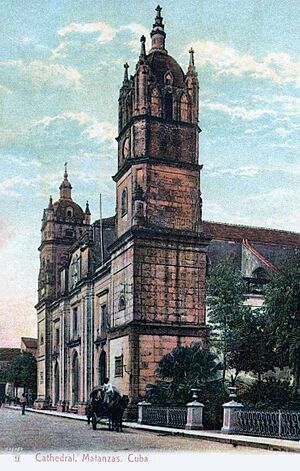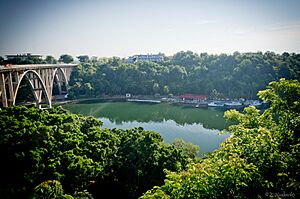Matanzas facts for kids
Quick facts for kids
Matanzas
San Carlos y San Severino de Matanzas
|
||
|---|---|---|

The city and bay of Matanzas
|
||
|
||
| Nickname(s):
La Atenas de Cuba
Venice of Cuba City of Bridges Flag city |
||

Matanzas municipality (red) within
Matanzas Province (yellow) and Cuba |
||
| Country | Cuba | |
| Province | Matanzas | |
| Settled | 1572 | |
| Founded | 1693 | |
| Established | 1695 | |
| Area | ||
| • Municipality | 317 km2 (122 sq mi) | |
| Elevation | 20 m (70 ft) | |
| Population
(2022)
|
||
| • Municipality | 163,631 | |
| • Density | 516.2/km2 (1,336.9/sq mi) | |
| • Urban | 151,555 | |
| • Rural | 12,076 | |
| Demonym(s) | Matancero/a | |
| Time zone | UTC-5 (EST) | |
| Postal code |
40100
|
|
| Area code(s) | +53 52 | |
Matanzas is the capital city of the Matanzas Province in Cuba. It's famous for its poets, rich culture, and Afro-Cuban traditions. The city is located on the northern coast of Cuba, right on the Bay of Matanzas.
Matanzas is about 90 kilometers (56 miles) east of Havana, the capital of Cuba. It's also 32 kilometers (20 miles) west of the popular resort town of Varadero.
People call Matanzas the City of Bridges. This is because 17 bridges cross the three rivers (Rio Yumuri, San Juan, and Canimar) that flow through the city. Because of its many bridges and waterways, it's also known as the "Venice of Cuba." Its history of famous writers earned it the nickname "La Atenas de Cuba" ("The Athens of Cuba").
Matanzas is also known as the birthplace of two important Cuban music and dance styles: danzón and rumba.
Contents
History of Matanzas
Matanzas was officially founded in 1693. Its full original name was San Carlos y San Severino de Matanzas. Before that, in 1690, a royal order said that 30 families from the Canary Islands should settle the bay and port of Matanzas.
During the colonial period, Matanzas became a major center for sugar plantations. Many African people were brought to the area to work on these plantations. This led to a strong presence of African traditions and culture in Matanzas, which can still be seen today.
In 1898, Matanzas was the site of the first battle of the Spanish–American War. American Navy ships attacked the city on April 25, 1898, right at the start of the war.
Why Matanzas Got Its Name
The name Matanzas means "massacre." It comes from a story from 1510. About 30 Spanish soldiers tried to cross a river to attack a native camp. They asked local fishermen for help with their boats.
However, once they were in the middle of the river, the fishermen flipped the boats. The Spanish soldiers wore heavy metal armor, so most of them drowned. Only two women survived. One of them, María de Estrada, was taken by a native leader called a Cacique. She later escaped and married Pedro Sánchez Farfán. This event is considered the first act of rebellion by native people in Cuba.
Geography of Matanzas
Matanzas is located on the north coast of Cuba. It sits around the Bay of Matanzas, which reaches deep into the island. Three rivers flow into this bay within the city: the Rio Yumuri, San Juan, and Canimar.
To the southeast, there's a hill called Pan de Matanzas. The Yumuri Valley and a coastal ridge separate this hill from the Atlantic coast.
The city is divided into four main areas: Versalles, Matanzas, Playa, and Pueblo Nuevo. The wider municipality also includes several smaller communities or barrios.
Population of Matanzas
In 2022, the city of Matanzas had a population of 163,631 people. The total area of the municipality is about 317 square kilometers (122 square miles). This means there are about 520 people living in each square kilometer.
Transportation in Matanzas
Air Travel
Matanzas is served by the Juan Gualberto Gómez Airport. This airport is located about 15 kilometers (9 miles) east of the city.
Train Travel

The city has two train stations. The main station is part of Cuba's main railway line, which connects Havana to Santiago de Cuba. There's also the Hershey Electric Railway, an electric train that goes to Havana from a separate station in the Versalles area.
Bus Services
Matanzas is also served by Viazul and Astro buses, which provide transportation to other parts of Cuba.
Roads
The Via Blanca highway connects Matanzas to Havana in the west and Varadero in the east.
Education in Matanzas
The University of Matanzas is the main higher education institution in the province. It offers many different study programs.
Attractions in Matanzas

Matanzas has many interesting places to visit:
- Pharmaceutical Museum - This museum was opened in 1882.
- Museo Historico Provincial de Matanzas - The Provincial History Museum tells the story of the area.
- El Consejo Provincial de Artes Visuales at the Galería Pedro Esquerré - Here you can see exhibitions of modern art.
- Sauto Theater - Teatro Sauto - This beautiful theater opened in 1863. It hosts plays, opera, ballet, and concerts. It is a National Monument of Cuba.
- Catedral San Carlos De Borromeo - A historic cathedral.
- Bellamar Caves - These nearby caves are also a National Monument of Cuba.
- Boating on the Canimar River - A fun way to see the natural beauty.
- Matanzas bridges - Explore the many bridges that give the city its nickname.
- Casino Español - This historic building is being restored.
- Necropolis de San Carlos Borromeo - A historic cemetery.
- Quinta de Bellamar - A heritage house and church.
Monuments in Matanzas
The Aqueduct of Matanzas is a national monument. It was built in 1870 and still supplies the city with water from the Manantial de Bello spring. It was an amazing construction for its time.
Famous People from Matanzas
Many notable people have come from Matanzas:
- Eufemio Abreu - A baseball player from the Negro league.
- Maria Magdalena Campos-Pons - An Afro-Cuban Artist known for photography and other art forms.
- José Cardenal - A former Major League Baseball player.
- Leo Cárdenas - Another former Major League Baseball player and 5-time All-Star.
- Rafael Cruz - An evangelistic preacher and the father of U.S. Senator Ted Cruz.
- Guillermo Heredia - A Major League Baseball player.
- Héctor Lombard - A Mixed martial artist.
- Sonora Matancera - A famous Cuban/Afro-Cuban band.
- Joseph Marion Hernández - The first Hispanic American to serve in the United States Congress.
- Los Muñequitos de Matanzas - A well-known rumba music group.
- Pérez Prado - A famous Mambo bandleader and composer.
- Javier Sotomayor - A high jumper who holds the current World Record and is an Olympic Champion.
- Joseph White - A talented Franco-Afro-Cuban violin player.
- Rafael Soriano (painter) - A famous painter and one of the founders of La Escuela de Artes Plásticas de Matanzas.
See also
 In Spanish: Matanzas para niños
In Spanish: Matanzas para niños









